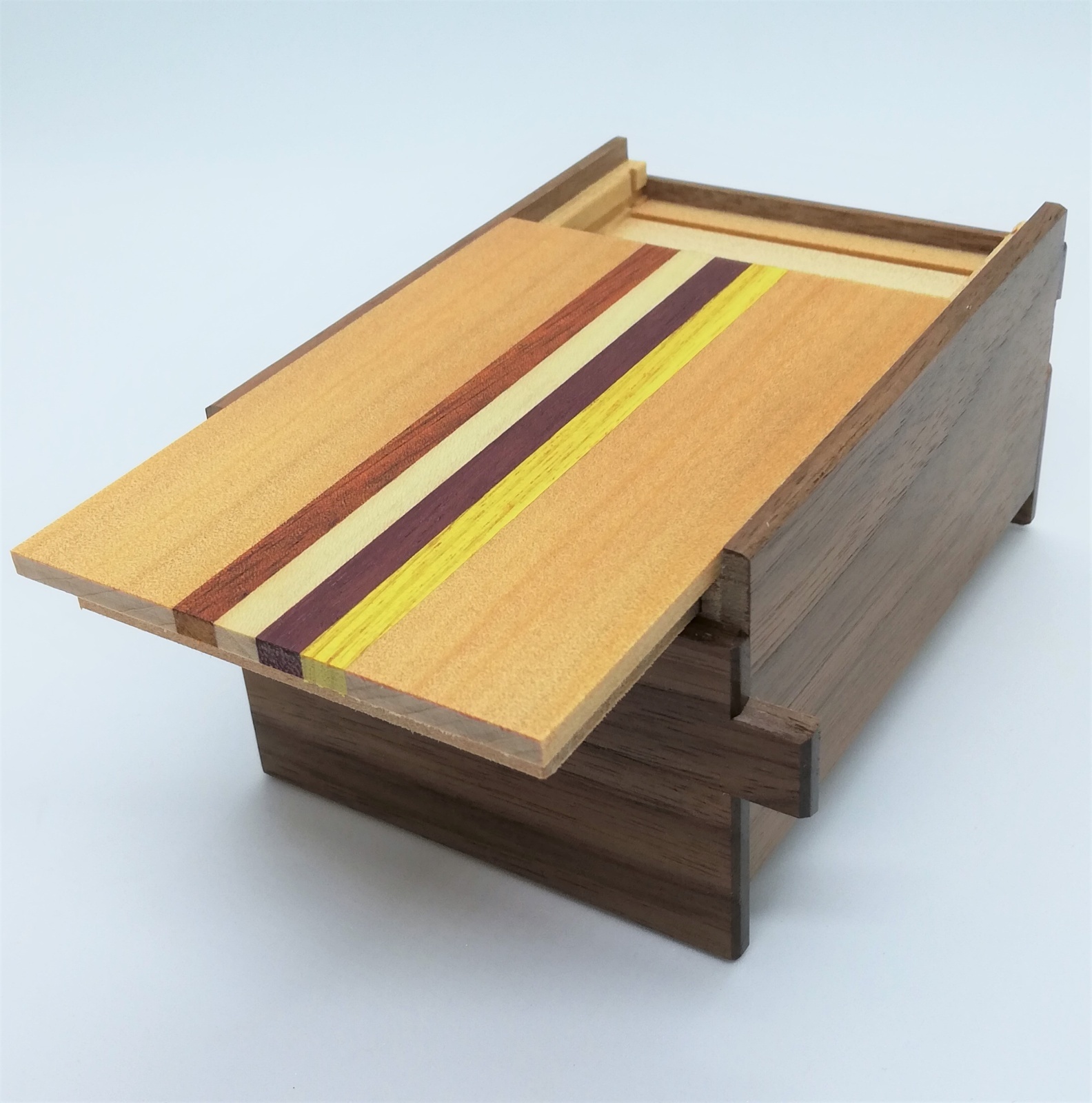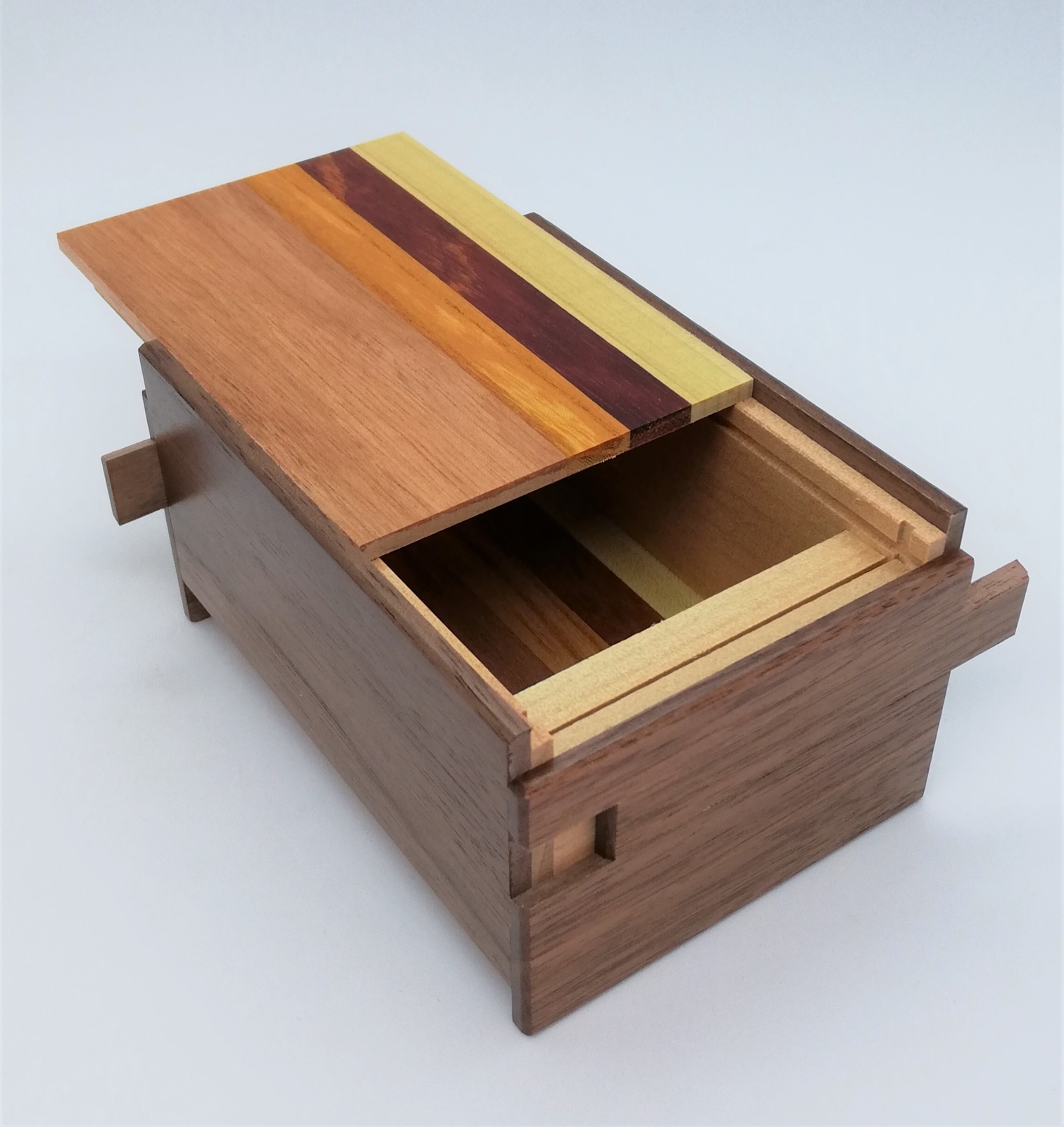4 sun natural wood boxes
The production of the 5-sun Drawer 10-step Japanese puzzle box is currently in progress, but I am also considering preparing for the next project.
The next project will be the production of 4-sun puzzle boxes, and I plan to make two types of boxes, as shown in the photos. In addition to these, I will also be making the usual 4-sun 14-step box with a design combining zebra-wood and walnut wood. Some of you may remember that this box was originally made in 2020. It seems that the previous sales were well-received, as I received a request for reproduction from an overseas shop. Although I originally intended it to be a one-time production, since it wasn’t specifically a limited edition, I’ve decided to make it again.
The two types of boxes in the photo are 12-step boxes. The internal structure of the 12-step and 14-step boxes is almost the same, with only one additional part distinguishing them, so I can produce them at the same time. Therefore, I will also be making the zebra-wood design box simultaneously. Additionally, all of these boxes feature walnut side panels, which makes their production together more convenient.
The first box in the photo features four solid wood strips in the center of the lid panel (and bottom panel), made of Rengas, Mizuki, Purple-heart, and Urushi wood. The wood used on both sides of these four types is "Agathis wood". I once wrote in an article that "agathis wood is traditionally used for the structure of puzzle boxes and had never been used for exterior design, but I started using it." It may have been around this time that I began doing so. Looking at photos from that period, I can also see puzzle boxes that used agathis wood for the top or side panels.
The second box in the photo features a top panel made from four different types of wood: Nyatoh, Keyaki, Rengas, and Poplar wood. The wood used in the small sections at the edges is "poplar wood". Although I haven’t used poplar wood much recently, around this time I was experimenting with it occasionally. While I was using it for design purposes, I was also testing whether it could be used as part of the structure of the puzzle boxes.
The reason for this was the sharp rise in wood prices and limited availability due to the COVID-19 pandemic. I was looking for a wood that could supplement agathis wood. Poplar wood is a stable, lightweight, and fine-grained wood, and it’s also widely available and relatively inexpensive. So, I bought some and gave it a try. In the end, I found that poplar could be used for components like the shafts and parts of the puzzle box, but not for mechanisms, such as the sliding parts of the trick (Aruki panels).
Since poplar wood is light, I thought it might work like Hoo wood (which can be used for aruki parts), but its grain turned out to be coarser than expected, and the mechanism didn’t slide smoothly.
However, the beautiful transition from white to green in poplar’s color is quite unique, and it adds a different charm compared to the woods I usually work with. So, I plan to continue using it for design purposes in the future.
The next project will be the production of 4-sun puzzle boxes, and I plan to make two types of boxes, as shown in the photos. In addition to these, I will also be making the usual 4-sun 14-step box with a design combining zebra-wood and walnut wood. Some of you may remember that this box was originally made in 2020. It seems that the previous sales were well-received, as I received a request for reproduction from an overseas shop. Although I originally intended it to be a one-time production, since it wasn’t specifically a limited edition, I’ve decided to make it again.
The two types of boxes in the photo are 12-step boxes. The internal structure of the 12-step and 14-step boxes is almost the same, with only one additional part distinguishing them, so I can produce them at the same time. Therefore, I will also be making the zebra-wood design box simultaneously. Additionally, all of these boxes feature walnut side panels, which makes their production together more convenient.
The first box in the photo features four solid wood strips in the center of the lid panel (and bottom panel), made of Rengas, Mizuki, Purple-heart, and Urushi wood. The wood used on both sides of these four types is "Agathis wood". I once wrote in an article that "agathis wood is traditionally used for the structure of puzzle boxes and had never been used for exterior design, but I started using it." It may have been around this time that I began doing so. Looking at photos from that period, I can also see puzzle boxes that used agathis wood for the top or side panels.
The second box in the photo features a top panel made from four different types of wood: Nyatoh, Keyaki, Rengas, and Poplar wood. The wood used in the small sections at the edges is "poplar wood". Although I haven’t used poplar wood much recently, around this time I was experimenting with it occasionally. While I was using it for design purposes, I was also testing whether it could be used as part of the structure of the puzzle boxes.
The reason for this was the sharp rise in wood prices and limited availability due to the COVID-19 pandemic. I was looking for a wood that could supplement agathis wood. Poplar wood is a stable, lightweight, and fine-grained wood, and it’s also widely available and relatively inexpensive. So, I bought some and gave it a try. In the end, I found that poplar could be used for components like the shafts and parts of the puzzle box, but not for mechanisms, such as the sliding parts of the trick (Aruki panels).
Since poplar wood is light, I thought it might work like Hoo wood (which can be used for aruki parts), but its grain turned out to be coarser than expected, and the mechanism didn’t slide smoothly.
However, the beautiful transition from white to green in poplar’s color is quite unique, and it adds a different charm compared to the woods I usually work with. So, I plan to continue using it for design purposes in the future.

